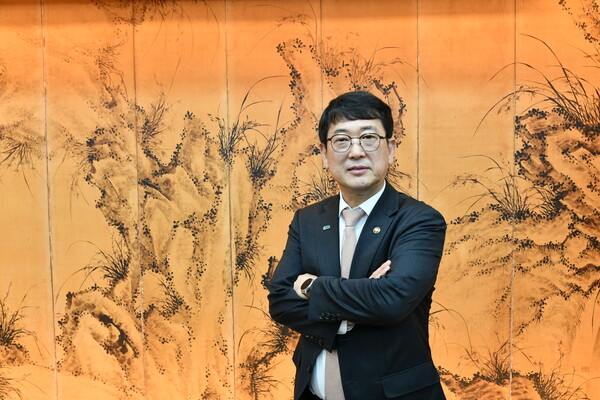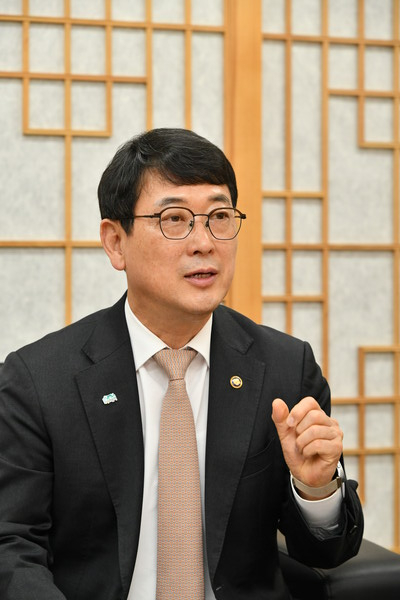
In 2024, there was an important turning point for the protection and management of Korean national heritage. The former Cultural Heritage Administration has been renamed the Korea Heritage Service. Its change represents the will to promote the preservation and management of cultural heritage more comprehensively and professionally. The Korea Heritage Service is now working to reorganize its organization and policies in line with changes in name and role, aiming to enhance and preserve the value of national heritage. The Dongguk Post get an opportunity to interview with Choi Eung-chon, an administrator of Korea Heritage Service.
Q1. What is the background and meaning of the name change of the National Heritage Administration?
The term “cultural property” that has been used so far was taken from Japan’s Cultural Heritage Protection Act enacted in 1950, and only Japan and Korea used the name “cultural property.” The “jae” of the word “cultural properties” is written as “財” in Chinese characters, but in the old classification system, it was inappropriate to express natural objects and people, such as natural monuments and intangible cultural properties (human cultural properties) as cultural properties with strong material characteristics. The Korea Heritage Service has implemented policies based on the “Cultural Property Protection Act” enacted in 1962, but over the past 60 years, there has been a limitation that the term cultural property does not cover the changed policy environment and expanded policy scope. The word “heritage” has a future-oriented meaning that encompasses not only objects but also nature, intangible, and spiritual values, and the term “national heritage” was adopted in consideration of its ability to cover an expanded policy range. The classification system of national heritage was reorganized into cultural heritage, natural heritage, and intangible heritage, increasing the connection with international standards such as UNESCO. In addition to promoting preservation and utilization policies tailored to the characteristics of each type of national heritage, we will design policies in a way that the national heritage is not simply something to protect and manage but can be cultivated and enjoyed together.
Q2. What substantial changes do you expect from the opening of the Korea Heritage Service?
The biggest change is that the Korea Heritage Service will implement policies in accordance with the basic principles of Article Seven of the Framework Act on National Heritage. In the meantime, if the preservation-oriented policy accompanied by regulations has been implemented to comply with the principle of preservation of the original form, the government will pursue policies aimed at creating value using national heritage, participation of the people, harmonizing with the socio-economic activities of the people, and developing areas. Examples include the National Heritage Landscape Improvement Project, which supports the improvement of the residential environment in the national heritage area, the Historical and Cultural Area Improvement Project, which is being implemented this year, and the Pre-cultural Heritage Contest Project to preemptively protect potential resources that will become national heritage in the future.
Q3. If there are any new policies or programs in national heritage management, what would it be?
In managing national heritages, the system is continuously being improved so that development and preservation can be balanced by selecting and concentrating on resolving public discomfort over national heritages by intensively regulating only places that must be protected according to the characteristics of each heritage and easing regulations in consideration of surrounding conditions.
Q4. Has there been any change in the protection and management methods of intangible cultural properties and natural heritage since the launch of the Korea Heritage Service?
In the case of intangible heritage, considerable effort is being made to expand the foundation for the transmission of intangible heritage by expanding the recruitment of passengers, improving treatment, and securing popularity. In the case of natural heritage, there was a case in which a hackberry tree, which became an issue in the drama “Weird Lawyer Woo Young-woo,” was designated as a natural monument, and now it has become a popular attraction, contributing to the revitalization of the region. It is a good example of regional revitalization by linking natural heritage and K-heritage in the region. There was a traditional landscape garden culture in the past, and we will support the complete restoration of traditional spaces and the creation of Korean gardens through surveys of palace landscapes, temples, hyanggyo(a local school in Joeson), and private houses. In addition, the recent climate change crisis has become an issue worldwide, and in particular, the preservation and management system for natural monuments (animals) sensitive to climate change will be strengthened.
Q5. What does the Korea Heritage Service do to balance conservation and development?
In order to ease the inconvenience of the people’s national heritage through selection and concentration, such as intensively regulating only places that must be protected according to the characteristics of each heritage, and gradually easing regulations in consideration of surrounding conditions, etc, the system is being improved by reducing the regulatory range from 500 meters to 200 meters among residential, commercial, and industrial areas. Seoul is more developed than other cities, so it protects its national heritage by reflecting the characteristics of individual cities, such as setting the range to 100 meters. In addition, by improving the settlement environment of local residents living with national heritage, the inconvenience of residents due to the protection of national heritage will also be resolved. To this end, in order to provide various support, such as maintaining the old living environment as a regional landscape improvement project of the national heritage where residents reside, it is promoting the convenience of residents’ residential life by preparing national heritage regional landscape guidelines and supporting the maintenance of living infrastructure such as communication, water supply and sewage, and gas in the national folk village.
Q6. There was a graffiti incident on the wall of Gyeongbokgung Palace earlier this year. What safety measures are in place to protect national heritages, including palaces?
In order to prevent artificial damage, such as graffiti damage on the wall of Gyeongbokgung Palace, a comprehensive measure to prevent the recurrence of damage to national heritage was announced at the beginning of the year. A disaster prevention facility construction project is being promoted to safely protect national heritage from natural and human disasters by expanding and installing crime prevention facilities such as CCTVs and surveillance sensors through a thorough investigation and on site inspections of national heritage in the blind spot of management monitoring.
Q7. The launch of the Korea Heritage Service seems to have sparked public interest and reaction. Is there a key achievement or goal that the Korea Heritage Service wants to achieve?
Korea ranks 10th in the UNESCO Heritage List (56 cases, 2024) and is a world-class national heritage powerhouse. The system of integrated management of the entire national heritage, including modern and contemporary heritage, burial heritage, and documentary heritage, is an advanced international model that is difficult to find overseas. It aims to establish and develop an integrated national heritage management system so that Korea can become a representative country leading the national heritage management system and become an international role model by allowing more national heritage to be registered as UNESCO heritage. The national heritage sector has also grown to an industrial scale, and international organizations such as UNESCO have recently presented economic perspectives such as regional economic development as a policy direction for the sustainable development of national heritage and the EU also recognizes national heritage as a resource for economic growth and employment. Accordingly, start-up companies will be recruited and discovered to support initial survival funds, and in the medium term, the industrial war will be activated as a place for job linkage, technology demonstration, and export. We will contribute to economic development by gradually supporting research and development, prototype production, commercialization, and market development from the research and planning stage to the actual commercialization of research results.
Q8. Please tell me what you want to say or give advice to Dongguk University students.
There is a saying that “If you stand, it is the ground, but if you start walking, it becomes the road.” If you have an unbroken aim and will, there is nothing you cannot achieve, and I want to tell you to always keep the spirit of challenge because you will achieve it someday.

- [463 Interview] Journey of Learning Korean with Experiences at DIKL
- [462 Interview] A Club That Spreads the Beauty of the Korean Language and Culture Through Education: Haram
- [464 Campus] The Role and Challenges of Student Organizations at Dongguk University
- [464 Clip] Lack of Available Courses for the Data Science Major
- [464 Social] The Dating Violence Plague: Its Facts and Causes
- [466 Interview] Journey Toward a Dream: Stories Shared by an Alumna

